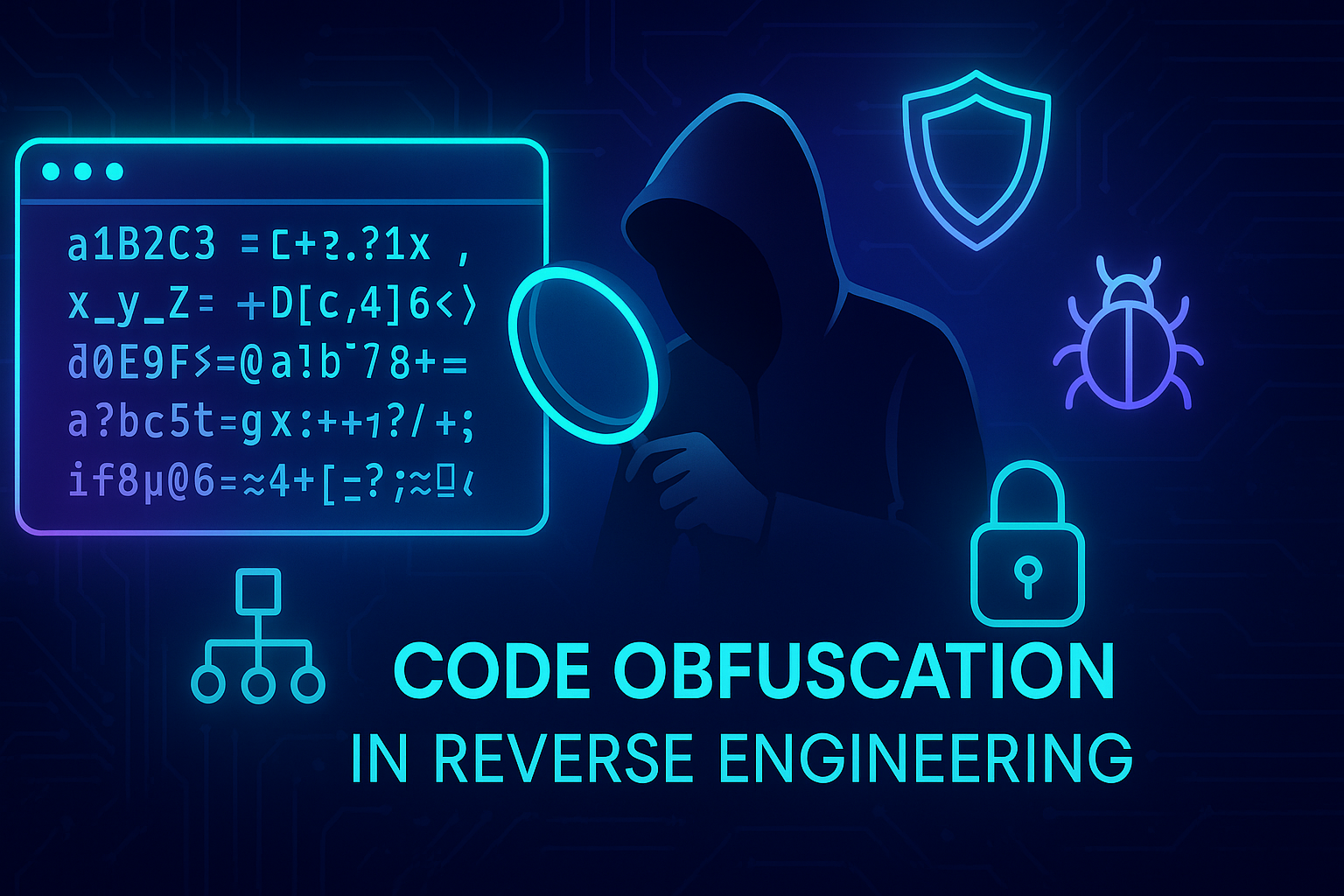In cybersecurity, protecting software from attackers who want to steal or analyze it is very important. Attackers often use reverse engineering — taking apart software to understand how it works.
To make reverse engineering harder, developers use code obfuscation — techniques that make the code confusing and difficult to understand without changing how it works.
This article explains the main code obfuscation techniques in detail, how attackers manually bypass these protections, what tools are used both for obfuscation and for reverse engineering, and includes practical examples.
What is Code Obfuscation?
Code obfuscation is a way to hide the real meaning of code by making it look complicated, confusing, or scrambled. The software still works correctly but is very hard for someone to read, analyze, or copy.
Common Code Obfuscation Techniques (Detailed)
1. Renaming (Identifier Obfuscation)
Description: Renaming replaces meaningful variable, function, and class names with random letters, numbers, or meaningless sequences. This removes clues about the code's logic.
Example:
Original:
def calculate_total(price, tax):
return price + (price * tax)
Obfuscated:
def a1B2C3(x, y):
return x + (x * y)
You lose the semantic meaning because calculateTotalPrice becomes a1B2C3.
Bypass Method: An attacker reads through code usage context to guess the meaning of variables/functions. Running tests with different inputs and observing outputs helps identify functionality.
print(a1B2C3(100, 0.1)) # Outputs: 110.0
Tools to Obfuscate:
- ProGuard (Java)
- ConfuserEx (.NET)
- JScrambler (JavaScript)
Tools to Reverse:
- de4dot (.NET deobfuscator)
- Ghidra, IDA Pro (for static analysis)
2. Control Flow Obfuscation
Description: This technique disrupts the natural flow of code by adding fake conditional branches, loops, or jumps that don't affect program output but confuse anyone reading it.
Example:
Original:
def is_even(n):
return n % 2 == 0
Obfuscated with extra branches:
def z9Xy(n):
flag = False
if n % 2 == 0:
flag = True
elif n % 3 == 0:
flag = False
else:
for i in range(5):
if i == 1000:
flag = True
return flag
The fake loop and conditions do nothing but make control flow complicated.
Bypass Method: Use a debugger (like OllyDbg or x64dbg) to step through instructions and ignore dead/fake branches. Mapping actual execution path reveals true logic.
print(z9Xy(4)) # True print(z9Xy(9)) # False
Tools to Obfuscate:
- Obfuscator-LLVM
- ConfuserEx
Tools to Reverse:
- IDA Pro with control flow graph visualization
- Ghidra
3. Code Encryption
Description: Critical code blocks are encrypted on disk and decrypted in memory at runtime, hiding their logic from static analysis.
Detailed Example: A packed executable contains encrypted code sections. When launched, it decrypts those sections before executing.
Example:
Original:
secret = "mypassword"
Obfuscated:
import base64 encoded = "bXlwYXNzd29yZA==" secret = base64.b64decode(encoded).decode()
Bypass Method: Run the program inside a debugger and pause execution after decryption occurs (usually at runtime start). Then dump the decrypted memory region for offline analysis.
import base64
print(base64.b64decode("bXlwYXNzd29yZA==").decode())
# Output: mypassword
Tools to Obfuscate:
- Themida
- VMProtect
Tools to Reverse:
- Scylla (memory dumper)
- OllyDbg/x64dbg with memory breakpoints
4. Dead Code Insertion
Description: Adding meaningless or unreachable code to confuse and lengthen the codebase, making analysis slower.
Example:
Original:
def greet(name):
return f"Hello, {name}"
With dead code:
def greet(name):
unused = 42
for i in range(10):
temp = i * 2
return f"Hello, {name}"
Bypass Method: Identify dead code by commenting/removing lines that don't affect output.
Tools to Obfuscate:
- VMProtect
- Themida
Tools to Reverse:
- Dynamic debuggers like x64dbg
- Code coverage tools to find unused code
5. Code Packing
Description: The executable or script is compressed or packed so that the original code is hidden until runtime when it unpacks itself in memory.
Example:
Original:
print("Hello World")
Obfuscated Code:
import zlib, base64
code = base64.b64decode("eJxLzs8tKkktLlGyUsrMz1NIyS9LLQYA0GQJbg==")
exec(zlib.decompress(code).decode())
Bypass Method: Run the packed executable in a safe VM, pause after unpacking, and dump the unpacked code for static analysis.
import zlib, base64
print(zlib.decompress(base64.b64decode("eJxLzs8tKkktLlGyUsrMz1NIyS9LLQYA0GQJbg==")).decode())
#Output: print("Hello World")
Tools to Obfuscate:
- UPX
- Themida
Tools to Reverse:
- UPX unpacker
- Scylla
6. Complex Data Structures
Description: Data is stored and manipulated using encrypted or transformed forms instead of straightforward structures.
Example:
Original:
password = "supersecret"
Obfuscated:
chars = [115, 117, 112, 101, 114, 115, 101, 99, 114, 101, 116] password = ''.join([chr(c) for c in chars])
Bypass Method: Trace data flow and decode manually or with scripts to reveal original data.
print(password) # supersecret
Tools to Obfuscate:
- VMProtect
- Custom encryption routines
Tools to Reverse:
- Scripting environments like Python for automated decoding
- Debuggers for memory inspection
How Attackers Bypass Code Obfuscation: Manual Methods (Summary)
- Carefully analyze code line-by-line.
- Use debugging tools to trace real execution paths.
- Dump decrypted/unpacked memory at runtime.
- Monitor code coverage to filter dead code.
- Decode or transform complex data manually or with scripts.
